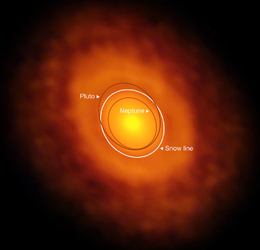ALMA Observes First Protoplanetary Water Snow Line Thanks to Stellar Outburst
Wednesday, July 13, 2016
 Simón Casassus, astrónomer of the U. of Chile |
|
Esta imagen del disco protoplanetario alrededor de la joven estrella V883 Orionis fue obtenida con ALMA en una configuración de línea de base larga. Esta estrella se encuentra en proceso de erupción, fenómeno que alejó la línea de nieve de la estrella y permitió detectarla por primera vez. El oscuro anillo en medio del disco es la línea de nieve, la zona donde la temperatura y la presión caen lo suficientemente como para permitir la formación de hielo. Las líneas representan respectivamente las distancias referenciales entre el Sol y Neptuno y el planeta enano Plutón. Créditos: ALMA (ESO/NAOJ/NRAO)/L. Cieza. |
New observations with the Atacama Large Millimeter/submillimeter Array (ALMA) have produced the first image of a water snow line within a protoplanetary disk. This line marks where the temperature in the disk surrounding a young star drops sufficiently low for snow to form. A dramatic increase in the brightness of the young star V883 Orionis flash heated the inner portion of the disk, pushing the water snow line out to a far greater distance than is normal for a protostar, and making it possible to observe it for the first time. The results will be published in the journal Nature on July 14, 2016.
Young stars are often surrounded by dense, rotating disks of gas and dust, known as protoplanetary disks, from which planets are born. Snow lines are the regions in those disks where the temperature reaches the sublimation point for most of the volatile molecules. In the inner disk regions, inside water snow lines, water is vaporized, while outside these lines, in the outer disk, water is found frozen in the form of snow. These lines are so important that they define the basic architecture of planetary systems like our own and are usually located for a typical solar-type star at around 3 au from the star.
However, the recent ALMA observations, to be published in Nature, show that the water snow line in V883 Orionis is currently at more than 40 au of the central star (corresponding to Neptune's orbit in our system), greatly facilitating its detection. This star is only thirty percent more massive than the Sun, but its luminosity is 400 times brighter as it’s currently experiencing what is known as a FU Ori outburst, a sudden increase in temperature and luminosity due to large amounts of material being transferred from the disk to the star [4]. This explains the displaced location of its water snow line: the disk has been flash-heated by the stellar outburst.
Lead author Lucas Cieza, from the Protoplanetary Disks Nucleus (MAD), explains: “The ALMA observations came as a surprise to us. Our observations were designed to look for disk fragmentation leading to planet formation. We saw none of that; instead, we found what looks like a ring at 40 au. This illustrates well the transformational power of ALMA, which delivers exciting results even if they are not the ones we were looking for.”
The discovery that these outbursts may blast the water snow line to about 10 times its typical radius is very significant for the development of good planetary formation models. Such outbursts are believed to be a stage in the evolution of most planetary systems, so this may be the first observation of a common occurrence. In that case, this observation from ALMA could contribute significantly to a better understanding of how planets form and evolve throughout the Universe.
A PARADIGM SHIFT
Although the scientific community was consistent in the existence of this line of snow-water in protoplanetary disks around forming stars, they had never observed. The reason is that this line is usually very close to its star. However, V883 Orionis despite having only 30% more mass than the sun, its brightness is 400 times more intense and experience what is now known as rash FU Ori, a sudden increase in temperature and luminosity due to the transfer of large amounts of material from the disk to the star, pushing the snow line at a much greater distance than normal, allowing observation.
For astronomers in charge of the study, this shift represents a paradigm shift in which some theories that seek to explain planetary formation because it has always regarded this line as static are based.
With the publication of their study in the prestigious scientific journal Nature, researchers believe that since Chile is doing frontier science. "The Chilean astronomical community has preferential access to professional observatories in our country. Six years ago we created the protoplanetary disks Millennium Nucleus in ALMA Early Sciencie in order to take that opportunity and do science first in the area of planetary formation. This line of snow is of fundamental importance in the formation of the planets and we could record it. Today's result shows that we have achieved", says Simon Casassus, professor at the U. of Chile, director to Protoplanetary Disks Nucleus (MAD) and coauthor of scientific research.





